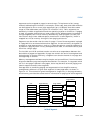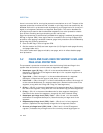
5-6 Vol. 3
PROTECTION
5.3 LIMIT CHECKING
The limit field of a segment descriptor prevents programs or procedures from
addressing memory locations outside the segment. The effective value of the limit
depends on the setting of the G (granularity) flag (see Figure 5-1). For data
segments, the limit also depends on the E (expansion direction) flag and the B
(default stack pointer size and/or upper bound) flag. The E flag is one of the bits in
the type field when the segment descriptor is for a data-segment type.
When the G flag is clear (byte granularity), the effective limit is the value of the
20-bit limit field in the segment descriptor. Here, the limit ranges from 0 to FFFFFH
(1
MByte). When the G flag is set (4-KByte page granularity), the processor scales
the value in the limit field by a factor of 2
12
(4 KBytes). In this case, the effective
limit ranges from FFFH (4 KBytes) to FFFFFFFFH (4
GBytes). Note that when scaling
is used (G flag is set), the lower 12 bits of a segment offset (address) are not checked
against the limit; for example, note that if the segment limit is 0, offsets 0 through
FFFH are still valid.
For all types of segments except expand-down data segments, the effective limit is
the last address that is allowed to be accessed in the segment, which is one less than
the size, in bytes, of the segment. The processor causes a general-protection excep
-
tion any time an attempt is made to access the following addresses in a segment:
• A byte at an offset greater than the effective limit
• A word at an offset greater than the (effective-limit – 1)
Figure 5-2. Descriptor Fields with Flags used in IA-32e Mode
31
24
23
22
2120 19 16
15
13
14 12
11
8
7
0
P
G
D
P
L
Type
1
L
4
0
0
A
V
L
D
ARC1
Code-Segment Descriptor
31
A
C
D
DPL
Accessed
Conforming
Default
Descriptor Privilege Level
G
R
Granularity
Readable
AVL Available to Sys. Programmer’s
L 64-Bit Flag
P Present


















